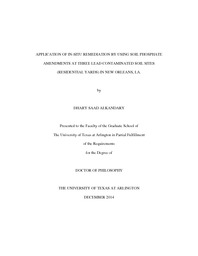
ATTENTION: The works hosted here are being migrated to a new repository that will consolidate resources, improve discoverability, and better show UTA's research impact on the global community. We will update authors as the migration progresses. Please see MavMatrix for more information.
Show simple item record
| dc.contributor.author | Alkandary, Dhary Saad | en_US |
| dc.date.accessioned | 2015-07-01T17:50:24Z | |
| dc.date.available | 2015-07-01T17:50:24Z | |
| dc.date.issued | 2014-12 | |
| dc.date.submitted | January 2014 | en_US |
| dc.identifier.other | DISS-12894 | en_US |
| dc.identifier.uri | http://hdl.handle.net/10106/24926 | |
| dc.description.abstract | Lead (Pb) contamination of soil continues as a threat to public health. The problem exists, in part, due to the abundance of lead in soil in certain contexts which has the potential to cause adverse health effects in children at relatively low exposure levels. The dominant source of lead in soils in the city of New Orleans, in the older urban areas close to residences, is old deteriorated lead-based paint. A cost-effective intervention method to address the problem of lead in these soils is needed to reduce the Pb exposure risk for people in these areas.Excavation and removal of lead (Pb) contaminated soils has been widely used as a remediation technique whereby the contaminated soil is removed, transported to a suitable landfill site, and clean soil is used to replace excavated soil. However, the cost of this "dig and dump" method is high, and the availability of an appropriate landfill may be problematic.Several alternative, low-cost, and effective methods are now being used to remediate lead contaminated soils. In situ methods involve the treatment of soil in the contaminated locations. The treatment technique is based on adding a chemical stabilization agent to the soil in such manner as to immobilize the contaminants. A chemical stabilization amendment that is widely used phosphate, as it has the ability to combine with metal contaminants and form a stable mineral that is sparingly soluble, and stable in low pH conditions (such as in the human stomach).The phosphate amendment is used in lead (Pb)-contaminated soils for several reasons. Namely, it combines with soluble Pb ions in the soil to form an insoluble crystalline lead phosphate mineral (pyromorphite). Also, pyromorphite has a low solubility product (Ksp) of approximately 10-80 so remains in the soil as immobile mineral. Apatite II is a biogenic phosphate, fish bones that can be applied to soil and it has been the focus of much attention because it is inexpensive, stable under various pH conditions, and it slowly and continuously supplies sufficient amount of phosphorous to form the mineral pyromorphite.Here we propose to assess the suitability of Apatite II as an in situ soil amendment for lead in soil at urban residential sites. Specifically for the use on lead contaminated soils in New Orleans, LA. Three different sites have been chosen for this study to prove the effectiveness of Apatite II in treating lead contaminated soils. Also, other types of amendments will be used as phosphate sources and a comparison will be made between each to show the effectiveness of Apatite II to the other phosphate agents. In our study, we propose to demonstrate that not only is Apatite II an effective intervention product, but is also an environmentally acceptable agent that does not excessively leach from the soil.It was anticipated that Apatite II would be a better phosphate amendment agent than other types of phosphate. The potential problems associated with rapidly releasing phosphate agents involve phosphorus entering groundwater and then passing into standing water bodies and causing eutrophication. The work here will determine the advantage of Apatite II over other forms of phosphate agents in terms of leaching into the soil solution. In addition to evaluating the efficacy of Apatite II, the "Treat Lock and Cover" (TLC) approach that has been promulgated by the Artist Mel Chin (http://www.fundred.org/about/operation-paydirt.php), that involves capping the amended soil with clean layer of soil, is also to be tested by evaluating the action of Apatite II at depth in the soil. The advantage of TLC is that a barrier is put in place (the clean capping soil) for the time period over which conversion of the soil Pb to a sparingly soluble form occurs.The principal objective of the study is to demonstrate that Apatite II can be presented as clean-up "method of choice" for lead contaminated soils in urban areas. By demonstrating this, we also propose to show that Apatite II can be used as a remediation agent on a large urban scale as there is a recognized need for city wide remediation of lead contaminated soils in cities like New Orleans, LA. | en_US |
| dc.description.sponsorship | Hunt, Andrew | en_US |
| dc.language.iso | en | en_US |
| dc.publisher | Environmental & Earth Science | en_US |
| dc.title | Application Of In-situ Remediation By Using Soil Phosphate Amendments At Three Lead Contaminated Soil Sites (residential Yards) In New Orleans, La. | en_US |
| dc.type | Ph.D. | en_US |
| dc.contributor.committeeChair | Hunt, Andrew | en_US |
| dc.degree.department | Environmental & Earth Science | en_US |
| dc.degree.discipline | Environmental & Earth Science | en_US |
| dc.degree.grantor | University of Texas at Arlington | en_US |
| dc.degree.level | doctoral | en_US |
| dc.degree.name | Ph.D. | en_US |
Files in this item
- Name:
- Alkandary_uta_2502D_12894.pdf
- Size:
- 43.19Mb
- Format:
- PDF
This item appears in the following Collection(s)
Show simple item record


